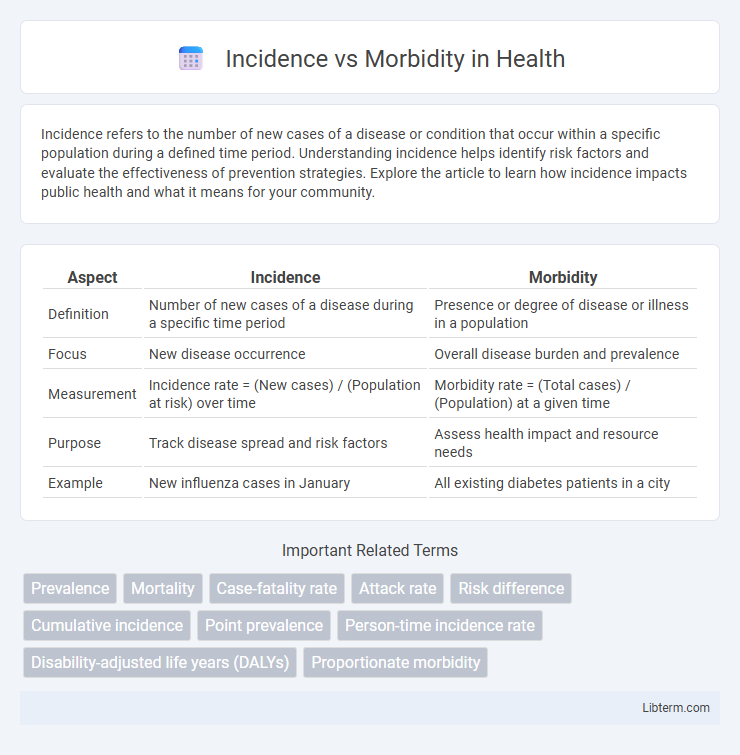Incidence refers to the number of new cases of a disease or condition that occur within a specific population during a defined time period. Understanding incidence helps identify risk factors and evaluate the effectiveness of prevention strategies. Explore the article to learn how incidence impacts public health and what it means for your community.
Table of Comparison
| Aspect | Incidence | Morbidity |
|---|---|---|
| Definition | Number of new cases of a disease during a specific time period | Presence or degree of disease or illness in a population |
| Focus | New disease occurrence | Overall disease burden and prevalence |
| Measurement | Incidence rate = (New cases) / (Population at risk) over time | Morbidity rate = (Total cases) / (Population) at a given time |
| Purpose | Track disease spread and risk factors | Assess health impact and resource needs |
| Example | New influenza cases in January | All existing diabetes patients in a city |
Understanding Incidence: Definition and Importance
Incidence measures the number of new cases of a disease occurring in a specified population during a defined time period, providing critical insight into the risk of developing that disease. This metric is essential for epidemiologists and public health officials to track the spread and emergence of conditions like infectious diseases, cancer, or chronic illnesses. Understanding incidence allows for better allocation of healthcare resources and the development of targeted prevention strategies.
Exploring Morbidity: What Does it Mean?
Morbidity refers to the prevalence of disease or health conditions within a population, highlighting the burden of illness and its impact on quality of life. It encompasses both acute and chronic conditions, measuring how frequently individuals experience symptoms, complications, or disability related to diseases. Understanding morbidity is crucial for public health planning, resource allocation, and developing targeted interventions to reduce the overall health burden.
Incidence vs Morbidity: Key Differences
Incidence measures the number of new cases of a disease occurring in a specific population during a defined time period, reflecting the risk of developing the condition. Morbidity encompasses the prevalence and impact of all existing cases, indicating the overall burden of disease on a population. Key differences between incidence and morbidity lie in their focus: incidence captures new case rates and disease onset, while morbidity addresses the total extent and health consequences of the disease.
Measuring Incidence in Public Health
Measuring incidence in public health involves quantifying the number of new cases of a disease or health condition within a specific population and time period, providing crucial data for tracking the spread and risk factors of illnesses. Incidence rate, often calculated as new cases per 1,000 or 100,000 individuals per year, distinguishes between newly occurring and existing cases, thereby offering insight into disease emergence rather than overall burden. Accurate incidence measurement supports targeted interventions, resource allocation, and evaluation of prevention strategies in epidemiology and health policy.
Methods for Assessing Morbidity
Morbidity refers to the presence of disease or symptoms within a population, while incidence measures new cases occurring in a specified time period. Methods for assessing morbidity include patient surveys, clinical examinations, and medical record analyses, each providing different levels of accuracy and detail. Epidemiological studies often use standardized questionnaires and diagnostic criteria to quantify morbidity rates and understand disease burden comprehensively.
Factors Influencing Incidence Rates
Incidence rates are influenced by factors such as population demographics, including age and gender, and environmental exposures like pollution or infectious agents. Behavioral aspects, such as lifestyle choices and vaccination coverage, also play a critical role in determining the frequency of new cases. Healthcare access and diagnostic practices further impact the detection and reporting of incidence, distinguishing it from morbidity measures.
Determinants of Morbidity Levels
Determinants of morbidity levels include genetic predisposition, environmental exposures, lifestyle factors such as diet and physical activity, and socioeconomic status, which influence the prevalence and severity of diseases within a population. Incidence measures new cases over a specific time, while morbidity reflects the overall disease burden, affected by chronic condition management and healthcare access disparities. Understanding these determinants aids public health strategies to reduce morbidity by targeting underlying risk factors and improving healthcare delivery.
Epidemiological Significance: Incidence and Morbidity
Incidence measures the number of new cases of a disease occurring in a specified population during a defined time period, serving as a critical indicator for identifying emerging health threats and planning preventative measures. Morbidity refers to the prevalence and impact of disease or disability within a population, highlighting the overall burden and guiding healthcare resource allocation. Understanding both incidence and morbidity is essential for epidemiologists to evaluate disease dynamics, assess public health interventions, and prioritize healthcare strategies effectively.
Impacts on Healthcare Policy and Resource Allocation
Incidence rates provide critical data on new cases of diseases, guiding healthcare policymakers in prioritizing preventive measures and allocating resources effectively to emerging health threats. Morbidity statistics, reflecting the overall disease burden, influence long-term healthcare planning by identifying chronic illness prevalence and healthcare service demands. Accurate incidence and morbidity data enable optimized budget distribution, enhance healthcare infrastructure, and improve targeted intervention strategies, ultimately shaping efficient public health policies.
Reducing Incidence and Morbidity: Effective Strategies
Reducing incidence involves implementing preventive measures such as vaccination programs, lifestyle modifications, and public health education to decrease the occurrence of new cases. Morbidity reduction focuses on improving disease management through early diagnosis, effective treatment protocols, and rehabilitation services to minimize complications and improve quality of life. Combining these strategies enhances overall health outcomes by addressing both disease onset and progression efficiently.
Incidence Infographic

 libterm.com
libterm.com